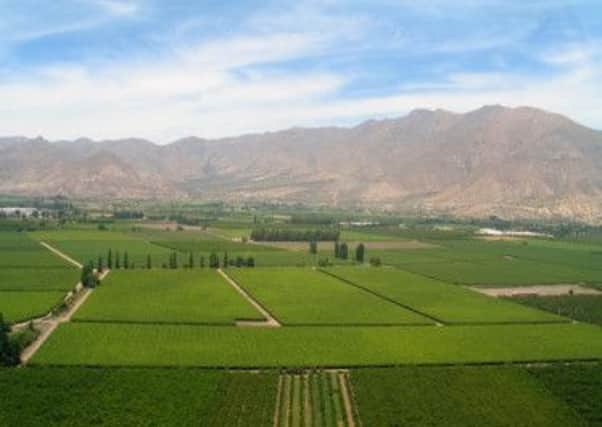Wine Club: The vibrant taste of Chile


I’ve had the builders in. They started in January and by the time you read this they will have gone, having done a total house transformation. Walls have been moved, bathrooms changed, new flooring laid and the kitchen, wow, the kitchen has been planned to the nearest millimetre yet still one cupboard doesn’t fit properly.
I have been moved out of my ‘office’ as I grandly call my working space, twice, and each relocation has involved moving computers, losing internet connection as signals prefer not to go round corners, and worst of all, I have had to move my working wine rack.
Advertisement
Hide AdAdvertisement
Hide AdThis is the structure, conveniently close by my desk where samples are stored while I photograph and log them, and then they wait their turn until I have a suitable slot in this column. I could taste everything that comes through the door, as it arrives, but I find that notes lose their immediacy and I prefer to line up similar samples to create a useful tasting sheet. Moving the wine rack and its contents created some major problems. Now you would think that the assembled family, with several degrees between then could manage a simple numeric system. But this simple task of keeping numbered and tagged bottles in some kind of order was lost on them.
The return move has been handled better. Now that my office has become my own space again, with bright white walls and power points in all the right places I decided to do the job myself. I have returned the bottles to their rightful places, wiping off layers of dust as I went, taking pleasure in grouping some bottles together ready for tasting. During this process I discovered layers of samples that were destined for discussion some time ago and which seem to have missed out. So, from my newly renovated tasting room/office/spare room, here they are.
I seem to have neglected Chile in recent months, with a serious backlog building up. This long thin country, with vineyards scattered across different latitudes and altitudes and with coastal areas now able to produce fresher, more vibrant flavours, is now moving up the quality scales. Limarí in the north, on the edge of the Atacama desert should be too hot for grapes but cool ocean breezes and limestone-encrusted soils have turned this area into one of the best places to grow Chardonnay. The Chilean arm of Spanish producer Miguel Torres has packed cinnamon-spiced, lime-fresh flavours into Cordillera Chardonnay 2011 (£11.40, Yorkshire Vintners), creating a wine that is light and clean on the palate, leaving the oak to subtly support the texture.
Slightly bigger in style with a definite creamy edge yet still clean as a whistle, Marques de Casa Concha Chardonnay 2011 (£11.99, Tesco) has the weight and complexity of a serious wine.
Advertisement
Hide AdAdvertisement
Hide AdMoving down the coast to the Casablanca Valley where morning mists hug the vines, keeping them distinctly chilly until almost midday, winemaker Alvaro Espinoza has been given free rein at Emiliana. He has been dedicated to organic and now biodynamic production for years. This is one of the most fascinating vineyards in Chile, designed with nature in mind so there are corridors of vegetation and streams for wildlife running through the vineyards while animals are raised on the estate to create a whole cycle of dynamic, integrated farming. Signos de Origen 2011, Chardonnay Viognier Roussanne Marsanne blend (£12.99, Hoults in Huddersfield) was the best in this line-up of Chilean whites for its fabulous complexity of apricots, peaches and passion fruit, underpinned by a clean, grapefruit freshness.
But while Chile does produce some excellent white wines, it is the reds that really pack flavour and power into the glass. Also from the Emiliana estate and made from organically-grown grapes, Novas Cabernet Merlot (£10.99, Morrisons) is sleek with blackcurrant and cherry fruit, lively and concentrated but with a clear chime of freshness to it.
A pair of reds under the Marques de Casa Concha label should have provided me with lush, ripe fruit but while the Syrah 2010 (£11.99, Tesco) was deep with layers of spice and damsons and definitely ready for drinking now, the Cabernet Sauvignon 2010 (£12.47, Penistone Wine Cellars) seemed to be closed and angular. This Cabernet is grown at high altitude at Puente Alto, one of Concha y Toro’s best and oldest estates, so perhaps it just needs a bit more time to come around.
Definitely ready although it will happily keep and develop for several more years, Terrunyo Cabernet Sauvignon 2010 from Block las Terrazas in Pirque (£21, The Wine Society) is a text-book example of how the quality of Chilean wines has been moving up. Here the fruit is concentrated with deep cassis flavours woven in with lead pencils and cigar box notes. It has a clear, defined structure and elegance.
Advertisement
Hide AdAdvertisement
Hide AdRaising money for charity while we spend is commonplace now and you can give 50p to three worthwhile causes when you buy Piggy Bank wines. Available through Tesco.com and waitrose.com, and now direct from the producer on www.shop.piggybankwine.com, Piggy Bank wines are sourced from France, Spain and Chile to provide simple, good flavours that taste good for their £7.99 price tag. The Sauvignon Blanc 2012 comes from Elqui in northern Chile and has clean, citrus-fresh, herbaceous notes with a touch of sherbet lemons while the Grenache is Southern French and I think it has the edge on style with layers of black raspberry fruit and a touch of liquorice and smoke. If you are holding a charity lunch this is the wine to serve. The charities are RNLI, Wateraid and Meningitis UK, and the money gets saved up until there is £10,00 in the piggy bank. Customer votes then decide on the split between charities.